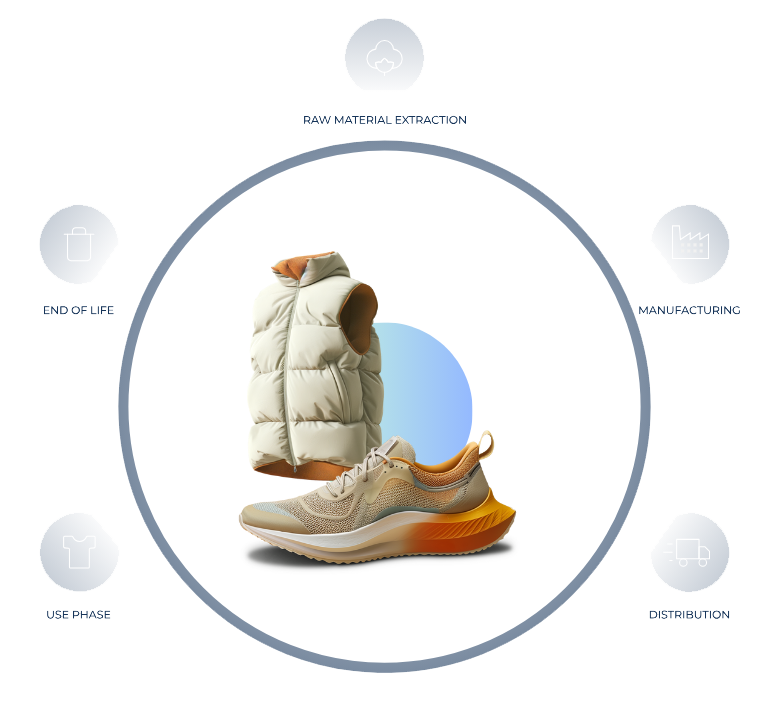Part One:The Basics
Winter is coming.❄️
Last week we had the pleasure of presenting to joint members of the European Outdoor Group (EOG) and the Bundesverband der Deutschen Sportartikel-Industrie e.V. (BSI). We discussed why a standardized approach to environmental impact assessment is crucial for the outdoor sector. Especially as brands aim to measure and report their environmental impact accurately.
There were many great questions, and we wanted to share a snapshot of the key takeaways from that presentation here.
What is the PEF Methodology?
PEF is a standardized approach developed by the European Commission to measure and communicate products’ environmental footprint throughout their lifecycle. It ensures consistent environmental claims across the EU, enabling brands to compare their products fairly and transparently.
Where does it start? With The Environmental Footprint (EF)

The Environmental Footprint, or EF, is a method developed to help companies compare and improve their environmental impact. It provides a common set of rules tailored for the European market. They are called the Product Environmental Footprint Category Rules (PEFCR).
The PEFCR provide specific guidelines for calculating product impacts, covering 16 environmental categories such as climate change, resource use, and water consumption.
Why Is PEF Important for the Outdoor Industry?
For outdoor brands, sustainability is more than a trend—it’s a core value. The PEF methodology offers a standardized, EU-approved way to assess and reduce Scope 3 emissions, which often make up the majority of a brand’s environmental impact. By using PEF, brands can evaluate sourcing choices, material selection, and production processes to drive sustainability.
Key Benefits of PEF for (not just) Outdoor Brands:
* Standardization: PEF provides a consistent method for comparing products across sectors.
* Regulatory Compliance: As EU regulations on environmental claims tighten, PEF ensures compliance.
* Holistic Approach: The methodology covers the full product lifecycle, from raw materials to end-of-life.
* Consumer Trust: With data-backed assessments, PEF builds consumer confidence in your environmental claims.
Comprehensive Coverage for Environmental Impact
The Product Environmental Footprint (PEF) method offers a standardized approach to measuring a product’s environmental impact across its entire life cycle, aligning with ISO standards 14040 and 14044. It’s a comprehensive way to understand the full environmental impact of a product, from raw material extraction to end-of-life disposal.
PEF follows the Product Environmental Footprint Category Rules (PEFCR), which provide detailed guidelines for specific industries. For example, the PEFCR for Apparel & Footwear v2.0 covers the entire product lifecycle for this sector. PEF uses EF Mid-point Indicator 3.1 for impact assessment, which acts like “checkpoints” for environmental impacts, such as resource use and pollution, before assessing the overall harm to health or the planet. These indicators help brands identify the stages in their product’s lifecycle—like production, transportation, or disposal—that have the most significant environmental impacts.
To ensure fair comparisons and consistency, PEF uses European weighting and normalization factors, allowing it to be applied broadly across different sectors and products, while incorporating 16 distinct environmental impact indicators.

Leveraging Over 5,500 Datasets for Detailed Environmental Impact Analysis
PEF is powered by an extensive database of over 5,500 datasets from sources like Ecoinvent, Blonk, and Thinkstep, providing detailed, diverse data for accurate impact analysis. Additional databases offer further enrichment to results, enabling brands to fine-tune their assessments based on specific materials or processes.
The Importance of Product Lifespan in Calculating PEF Scores
The PEF Score reflects the total environmental footprint of a product over its expected lifespan. For instance, if you have a pair of shoes designed to last a year, the PEF will calculate the environmental impact based on that full year of use. Longer-lasting products will generally have a lower impact per day because the environmental cost is spread over a more extended period.
Conclusion: The Importance of PEF for Outdoor Brands – Stay Tuned for Part 2 on Lifecycle Analysis and Long-term Sustainability
The PEF methodology offers a powerful, standardized framework for outdoor brands to measure, reduce, and communicate their environmental impact. By using PEF, companies can ensure compliance with EU regulations, build consumer trust, and take a holistic approach to sustainability. From sourcing raw materials to managing end-of-life disposal, the PEF methodology provides a consistent way to evaluate and improve a product’s environmental footprint across its entire lifecycle.
In Part 2, we’ll dive deeper into the lifecycle analysis process. We’ll explore how PEF helps track long-term environmental progress, and look at a real-world example of PEF in action. Stay tuned to see how this methodology can drive even greater sustainability for your brand.
Cant wait for part two? Sign up for a demo
